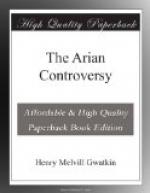[Sidenote: Return of Athanasius, Feb. 362.]
Back to their dioceses came the survivors of the exiled bishops, no longer travelling in pomp and circumstance to their noisy councils, but bound on the nobler errand of seeking out their lost or scattered flocks. Eusebius of Vercellae and Lucifer left Upper Egypt, Marcellus and Basil returned to Ancyra, while Athanasius reappeared at Alexandria. The unfortunate George had led a wandering life since his expulsion in 358, and did not venture to leave the shelter of the court till late in 361. It was a rash move, for his flock had not forgotten him. Three days he spent in safety, but on the fourth came news that Constantius was dead and Julian master of the Empire. The heathen populace was wild with delight, and threw George straight into prison. Three weeks later they dragged him out and lynched him. Thus when Julian’s edict came for the return of the exiles, Athanasius was doubly prepared to take advantage of it.
[Sidenote: Council of Alexandria discusses:]
It was time to resume the interrupted work of the council of Seleucia. Semiarian violence frustrated Hilary’s efforts, but Athanasius had things more in his favour, now that Julian had sobered Christian partizanship. If he wished the Galileans to quarrel, he also left them free to combine. So twenty-one bishops, mostly exiles, met at Alexandria in the summer of 362. Eusebius of Vercellae was with Athanasius, but Lucifer had gone to Antioch, and only sent a couple of deacons to the meeting.
[Sidenote: (1.) Returning Arians.]
Four subjects claimed the council’s attention. The first was the reception of Arians who came over to the Nicene side. The stricter party was for treating all opponents without distinction as apostates. Athanasius, however, urged a milder course. It was agreed that all comers were to be gladly received on the single condition of accepting the Nicene faith. None but the chiefs and active defenders of Arianism were even to be deprived of any ecclesiastical rank which they might be holding.
[Sidenote: (2.) The Lord’s human nature.]
A second subject of debate was the Arian doctrine of the Lord’s humanity, which limited it to a human body. In opposition to this, the council declared that the Lord assumed also a human soul. In this they may have had in view, besides Arianism, the new theory of Apollinarius of Laodicea, which we shall have to explain presently.




